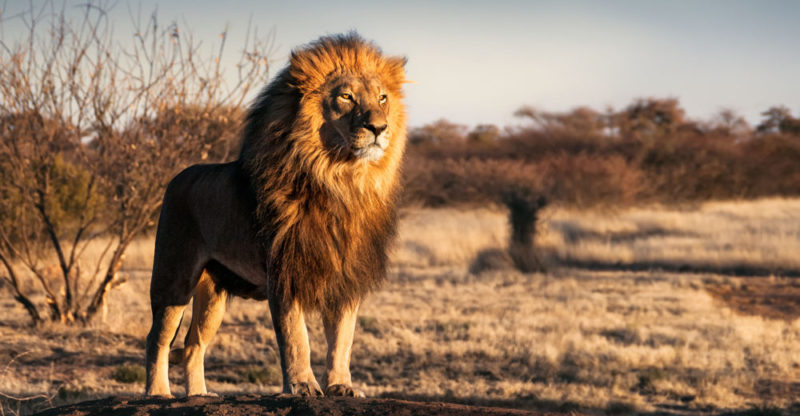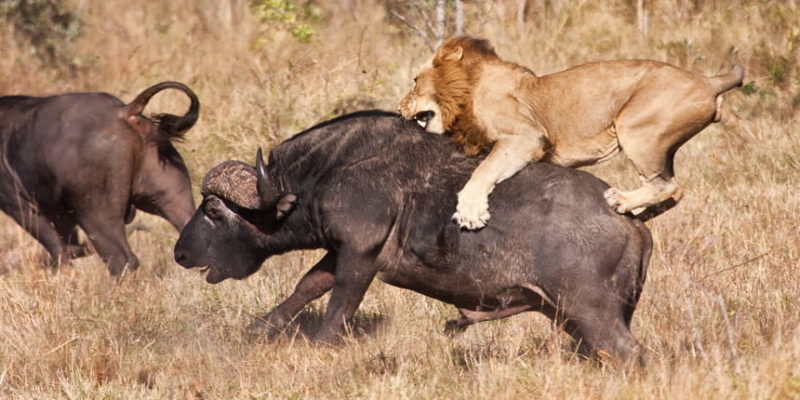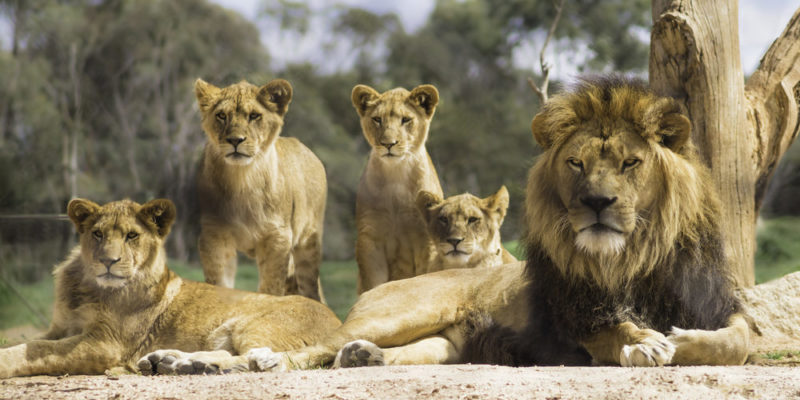We explain everything about the lion, the type of habitat in which it lives and the abilities of this feline. In addition, its characteristics, food and more.
What is a lion?

The lion (scientific name Panthera leo ) is a quadruped mammal of the felidae family, typical of sub- Saharan Africa and some regions of the Congo and India. It occupies the top place in the food chain, as it is one of the largest predators on the planet today.
Since the dawn of humanity, the lion has been one of the animals most admired for its fierceness and strength, and for those same reasons feared and hunted. He is known as the "King of the Jungle" or "King of the animals", and his deep roar is well known.
Lions are currently a species threatened by human activity, and their numbers have dramatically decreased since the invention of firearms. With a presence in zoos around the world, it is one of the species that is most hard-fought to protect.
Origin of the lions
Lions are related to other large feline predators such as the tiger and the jaguar, originating from central Asia 3.5 million years ago.
However, the Panthera leo species emerged in Africa about 1 million years ago, separating evolutionarily from the rest during the Pleistocene.
At some point it spread throughout America, Europe and the Middle East, giving rise to other species that are now extinct. In fact, in Greco-Roman antiquity it was common to find lions in the Asian Mediterranean regions, such as Turkey, Israel, Palestine and even Greece.
Lion habitat

The lion is a species adapted to the life of the savannah, in the plains where it can run at great speeds. They usually take refuge from the sun under acacias and other trees in the African region, where they hunt antelope, emus and other endemic species.
Most of today's lions live in East and South Africa, where it is estimated that their population does not exceed a thousand adult specimens.
Description of the lion
Lions are large, four-legged animals that are golden or light beige in color. Their graceful bodies can reach weights of 160-260 kg (males) or 120-182 kg (females), and are around three meters in length, from head to tip of the tail.
Its four legs are endowed with powerful muscles and sharp claws at the end, with which they hold their prey. Their powerful jaws with three-inch canine teeth make them terrifying hunting machines.
Lions can live between 14 and 20 years, especially in captivity. They are non-domesticable predators, which can eat up to 7 kilos of meat a day.
Females and males are easy to distinguish, since the latter have a huge dark-colored mane around their necks , which allows them to show themselves larger than they are during confrontations with competitors.
Lion skills

Lions have powerful and graceful bodies, which they use to communicate through a range of facial and body expressions that function as visual gestures. To this is added its varied vocalization capacity, among which is the most intense roar of all the felines in the world.
The physical strength of lions allows them to pounce on their prey by grasping them with the claws of their front legs. Then they bite the neck of the prey until achieving suffocation or exsanguination.
The fierceness of lions is legendary, and many males meet a violent death in combat against younger ones, vying for pride in the pride and access to females.
Lion personality

Lions are the most sociable of the felines. They form herds in which the females bond in a family way, raising their cubs together, under the presence of a few males.
These groups can range from 4 to 37 members, and occupy a well-defined territory, in which the presence of intruding lions is not tolerated. The number of members depends directly on the abundance of the prey.
The females, in fact, can hunt in groups, sharing the food for the benefit of the herd. The males, on the other hand, must hunt their own food and can also wander alone, being called nomadic males, devoid of territory. Their habits, in general, are more active at night.
Lion feeding
Hunting is in the genes of lions, and a pride of them can unleash the fiercest pursuit, albeit for relatively short distances. Its diet is purely carnivorous, and it can sometimes resort to scavenging.
Lions invest a lot of energy in the pursuit of prey and they often fail in their attempts. Therefore, they spend a lot of time on the prowl and take advantage of the opportunities provided.
Lion reproduction

By four years of age, most lions have already reproduced. In each litter she has between one and four young. During their varied seasons of heat, females and males can copulate between 20 and 40 times daily. Once internal fertilization has occurred, gestation takes an average of 110 days.
The young are born blind and do not open their eyes until a week after they are born. Therefore, their full care is in charge of their mother, who moves them from burrows several times during the nine to ten weeks it takes to integrate into the herd.
Breastfeeding can be done collectively, as lionesses in the same pride often synchronize their reproductive cycles and have young at the same time.
Close relatives of lions
Genetic studies of the lion and other species of felines have revealed that they are all descendants of the Asian tiger, whose oldest remains date from 4.1 to 5.9 million years and were found in 2010 in Tibet.
Native to central Asia, it is estimated that these animals spread around the world in the times before the last ice age and thus gave rise to a family of big cats: lions, tigers, panthers, jaguars and leopards.
The lion in culture

Lions have aroused human admiration since ancient times. His majestic bearing, ferocity and deafening roar became symbols of human bravery, to the point that he became a frequent icon of warrior banners and a totemic animal.
The ancient Romans knew and admired them, and it is believed that they fed them with Christians in the ancient Colosseum, as a form of entertainment. Hence, they were later common as a circus animal, in acts starring a "tamer".
For its part, the Christianity saw the lion symbol of Jesus Christ, and San Marcos, one of the four evangelists. For this reason, it was common during the Middle Ages to see the lion become an emblem of royal houses and of the Christian military aristocracy of the time.
This symbol was inherited from the mythical Lion of Judah mentioned in the Genesis of the Bible, symbol of the descendants of David, second monarch of the United Kingdom of Judah and Israel. Its mane also refers to the crown of the sun, as well as its golden color, which is why it was considered a celestial, mythical, sacred animal.
State of conservation
The lion is a vulnerable species, whose encounters with humanity have led to the rapid and dramatic decline of its territory. They have been practically confined to a few regions of sub-Saharan Africa.
Currently, the total count of adult specimens does not exceed a thousand, since it has decreased between 30% and 50% in recent times despite inhabiting nature reserves and national parks.
Anas is an editor of a prestigious publishing company in the United States. She studied Mathematics in Arizona. Anas is also a teacher and one of her long-term goals is to build an institution that offers free education to everyone who are financially not stable. .
Leave a reply
Your email address will not be published. Required fields are marked *Recent post

Sport: What Is It, Types, Risks, Features, Characteristics and Examples

Dogs: Emergence, Features, Characteristics, Feeding and Breeds

Story: Definition, Elements, Structure, Features and Characteristics

